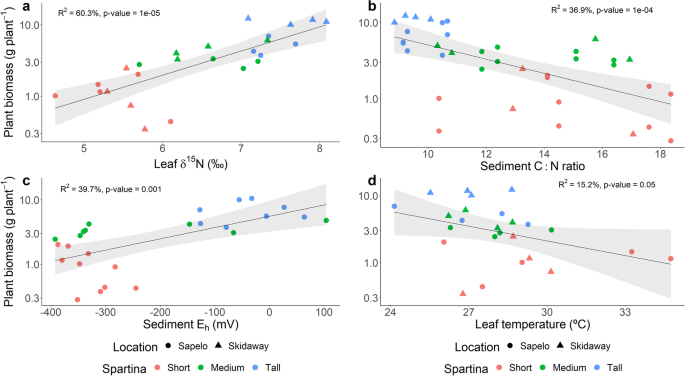2022-03-21 ジョージア工科大学
・塩性湿地は水をきれいにし、海岸線を高潮から守り、魚や貝の生息地を提供しています。
・この研究で、これらの湿地帯を支配する草の一種が、その根と周囲の土壌にバクテリアを持ち、栄養分を供給することで生産性に影響を与えていることが明らかになり、生態系全体における土壌微生物の重要性が浮き彫りになりました。
<関連情報>
- https://research.gatech.edu/salt-marsh-grass-georgias-coast-gets-nutrients-growth-helpful-bacteria-its-roots
- https://microbiomejournal.biomedcentral.com/articles/10.1186/s40168-021-01187-7
The core root microbiome of Spartina alterniflora is predominated by sulfur-oxidizing and sulfate-reducing bacteria in Georgia salt marshes, USA
Jose L. Rolando,Max Kolton,Tianze Song &Joel E. Kostka
Microbiome volume 10, Article number: 37 (2022)

Abstract:
Background
Salt marshes are dominated by the smooth cordgrass Spartina alterniflora on the US Atlantic and Gulf of Mexico coastlines. Although soil microorganisms are well known to mediate important biogeochemical cycles in salt marshes, little is known about the role of root microbiomes in supporting the health and productivity of marsh plant hosts. Leveraging in situ gradients in aboveground plant biomass as a natural laboratory, we investigated the relationships between S. alterniflora primary productivity, sediment redox potential, and the physiological ecology of bulk sediment, rhizosphere, and root microbial communities at two Georgia barrier islands over two growing seasons.
Results
A marked decrease in prokaryotic alpha diversity with high abundance and increased phylogenetic dispersion was found in the S. alterniflora root microbiome. Significantly higher rates of enzymatic organic matter decomposition, as well as the relative abundances of putative sulfur (S)-oxidizing, sulfate-reducing, and nitrifying prokaryotes correlated with plant productivity. Moreover, these functional guilds were overrepresented in the S. alterniflora rhizosphere and root core microbiomes. Core microbiome bacteria from the Candidatus Thiodiazotropha genus, with the metabolic potential to couple S oxidation with C and N fixation, were shown to be highly abundant in the root and rhizosphere of S. alterniflora.
Conclusions
The S. alterniflora root microbiome is dominated by highly active and competitive species taking advantage of available carbon substrates in the oxidized root zone. Two microbially mediated mechanisms are proposed to stimulate S. alterniflora primary productivity: (i) enhanced microbial activity replenishes nutrients and terminal electron acceptors in higher biomass stands, and (ii) coupling of chemolithotrophic S oxidation with carbon (C) and nitrogen (N) fixation by root- and rhizosphere-associated prokaryotes detoxifies sulfide in the root zone while potentially transferring fixed C and N to the host plant.

